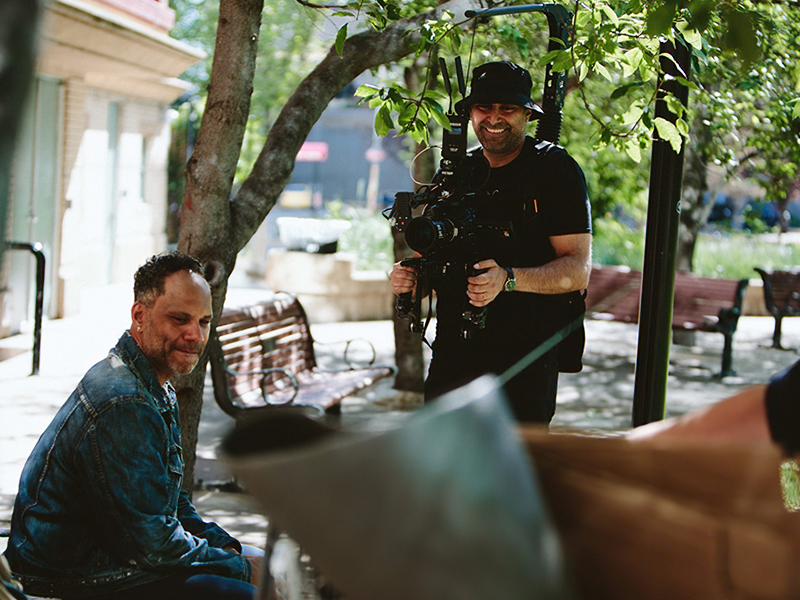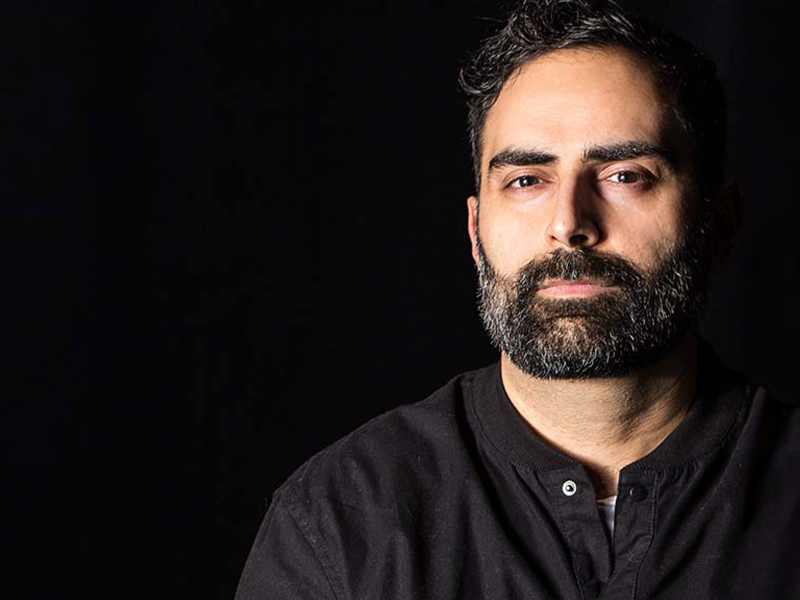Ramin Eshraghi Yazdi
Filmmaker wears as many hats as needed to live his creative life
Calgary filmmaker Ramin Eshraghi-Yazdi’s creative life launched years ago, as an economics student at the University of Calgary, over dinner with his friend Reynard Li, who was in art school — and had access to a movie camera.
“We started talking and came up with an idea that we both thought was amazing,” he says, in an emailed reply to a question. They submitted the experimental film to a local festival that rejected it, but something inside Eshraghi-Yazdi was ignited. “By the time the experience was over something was planted deep inside me,” he says, “and after that I really had no choice.”
“I had to do this.”
Economics was out. Living a creative life — the kind where the economics don’t always add up but you have to do it anyway — was in.

A 10-HAT PROJECT
Flash forward a few decades — after directing hundreds of projects including music videos; creating mini and feature documentaries funded through places like Telus Optik Originals; curating a one-day international short film festival at cSpace; showcasing local talent on CJSW FM for a decade (2001 – 2012); and showrunning a sketch comedy show — to fall 2023: Eshraghi-Yazdi’s debut full-length feature drop was screened as part of the Calgary International Film Festival.
The film, shot in three chunks over a span of 20 days in the summer of 2022, is a drama about the relationship between an aging dancer and a young man on the cusp of a life of crime — in other words, a dance-crime drama, which may be its very own genre.
Filmed by an all-Calgary crew, starring an all-Calgary cast, drop was the kind of micro-budget, guerilla filmmaking experience that can be tough on the nerves of its creators even if it is generally the origin story of just about all of them.
For Eshraghi-Yazdi, who wrote, directed, produced and served as his own cinematographer, it was an all-encompassing experience.“I really felt the weight of it on this project,” he says. When I say it sounds as if he wore a lot of hats on set, he says, “This is at least a 10-hat project.” But it was also an expression of how Eshraghi-Yazdi gets inspiration from other art forms — particularly dance, which he says has found its way into many of his projects.
The plot of drop came a suggestion from longtime DJD company member Kaleb Tekeste. “For a film like drop, dance and choreography is as important as any other aspect if not more so,” says Eshraghi-Yazdi. drop builds energy from its dance sequences, rather than from stuff blowing up. “Filming dance is a lot like filming an action sequence,” he says. “I didn’t want it to be a music video. I wanted it to be as if the audience was watching a performance.
“I didn’t want to use dance as a gimmick,” he says. “They (dancers) work within the world of the story.”
The film wrapped in the summer of 2022, but the wrap party didn’t actually take place until September 26, 2023 when drop premiered at CIFF.
“It was a lovely experience,” he says. “Given it was a hometown screening, most of the cast and crew made it out. I have known and been working with many of the cast and crew for years, so we are like a little filmmaking family. And the new collaborators on this project have quickly fallen into the ‘family’ category.
“It was a family affair.”

WHY MAKE FILMS?
And while there’s a happy-ish ending attached to drop, the reality of independent filmmaking is pretty rough. All of which begs the question: why make films at all? If you need to live a creative life, there are lots of easier, less expensive, less stressful ways to do it: TikTok and YouTube and Instagram stars, most of whom create hyper short-form content on their phones, are breaking out all over the planet.
Eshraghi-Yazdi says the first experimental film he made while still an economics student fueled him, and he’s still got the need to tell cinematic stories. “I started making films because I needed an outlet for the stories and scenarios in my head,” he adds. “An image or sequence would pop up in my mind and take up residence until I found a way to get them out.”
Now that he’s completed drop, Eshraghi-Yazdi is entering the film in festivals and trying to find a distributor, which is another huge challenge on top of the huge challenge that was shooting and editing the film
He’s also working on a scripted television idea and revisiting his love of comedy, which he explored in the YouTube series Cowtown back in 2015, featuring a then-unknown Andrew Phung before he went on to star in Kim’s Convenience and Run the Burbs on CBC.
He’s also working on a feature script set in northern Alberta with Shane Ghostkeeper and Sarah Houle-Lowry. The trio have a production company called Muskego, with a mandate to tell stories about northern Alberta.
Eshraghi-Yazdi, who divides his time between Calgary and Montreal, calls his main production company Nur Films. When I ask what ‘nur’ stands for, he writes back: “Nur means light in many languages including Farsi.”
It might take way more hats than fit comfortably on one man’s head, but Eshraghi-Yazdi is willing to wear as many as he has to in order to live his creative life.
“Ideas are easy for me,” he says. “I have a million and I seem to be able to generate them quite fast and easily. It is everything else that seems to be very work intensive and taxing. All I need is a bit of quiet and a few minutes to ponder, let my mind explore. Then I start getting a warm feeling inside when something is forming in my mind’s eye that I like.
“And once it is there,” he adds, “it has to find a way out, which sometimes takes months to do, other times years.”

